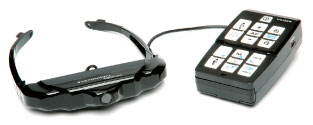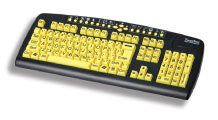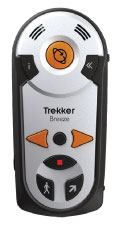
By Patrick Dundas
In Part 1 of this article, which appeared in the July issue of L&T, author Patrick Dundas described how eyecare practitioners can serve the visual needs of the exploding age-related macular degeneration (AMD) patient population with nutritional supplements, diagnostic instruments and testing, and low vision aids such as portable video magnifiers, and desktop video magnifying systems. In Part 2, he explores the use of low vision aids such as video eyewear, optical magnifiers, magnification software and low vision friendly keyboards as well as lighting and sun filters and wireless GPS systems and readers.
VIDEO EYEWEAR
 Inspired by a NASA developed video headset, Enhanced Vision designed their Jordy low vision video eyewear product. Worn like eyeglasses with a built-in high- resolution camera and two LCD screens, Jordy users can magnify and see images at near, mid-range and distance, with added features like auto-focus, zoom magnification, multiple contrast modes and wide field-of-view. Jordy comes with a docking station that can be connected to a monitor for conversion to a desktop video magnifier.
Inspired by a NASA developed video headset, Enhanced Vision designed their Jordy low vision video eyewear product. Worn like eyeglasses with a built-in high- resolution camera and two LCD screens, Jordy users can magnify and see images at near, mid-range and distance, with added features like auto-focus, zoom magnification, multiple contrast modes and wide field-of-view. Jordy comes with a docking station that can be connected to a monitor for conversion to a desktop video magnifier.
The newest eyewear product, SightMate, comes from Vuzix. Like Jordy, SightMate is worn like eyeglasses with a hand-held control unit. Focusing is button controlled with added features like freeze frame and tilt control. Optional accessories include a DVD player, magnifying mouse and hand-held video magnifier.
Video eyewear products combined with the wide selection of portable and desktop video magnifiers covered in Part 1 provide innovative new dispensing options for ECPs. These breakthrough low vision aids range in price from just under $400 for select portable units to over $3,000 for fully equipped desktop systems and everything in between. Any one of these devices can change patients’ lives, opening the door to actively pursue personal, educational and career goals.
OPTICAL MAGNIFIERS
 When cost, simplicity or performing special tasks are the important factors, optical magnifiers become the choice. Product selection is virtually unlimited, ranging from high-plus prismatic reading glasses and spectacle mounted magnifiers to pocket magnifiers and telescopes from leading companies like Eschenbach, Walters Low Vision and Designs for Vision. The newest high-quality hand-held and stand magnifiers are available with aspheric optics and built-in LED illumination. One of the most popular new products for distance viewing is the easy-to-fit MaxTV Galilean telescopic system from Eschenbach. It is worn like eyeglasses so that low vision patients can enjoy hands-free lightweight binocular viewing for distances of 10 feet to infinity for watching TV, theater and sporting events.
When cost, simplicity or performing special tasks are the important factors, optical magnifiers become the choice. Product selection is virtually unlimited, ranging from high-plus prismatic reading glasses and spectacle mounted magnifiers to pocket magnifiers and telescopes from leading companies like Eschenbach, Walters Low Vision and Designs for Vision. The newest high-quality hand-held and stand magnifiers are available with aspheric optics and built-in LED illumination. One of the most popular new products for distance viewing is the easy-to-fit MaxTV Galilean telescopic system from Eschenbach. It is worn like eyeglasses so that low vision patients can enjoy hands-free lightweight binocular viewing for distances of 10 feet to infinity for watching TV, theater and sporting events.
For more demanding bioptic telescope applications, Ocutech systems use Keplerian optics to achieve a wide field-of-view with the convenience of auto-focusing in the VES-AF model. Their new VES-Sport features lightweight modern styling.
MAGNIFICATION SOFTWARE & LOW VISION FRIENDLY KEYBOARD
 For patients who want to use their computer but need magnification, there are software products designed for the visually impaired. Ai Squared, Freedom Scientific and Clarity offer Windows based software for laptop or home based PC with variable magnification up to 36X. Users can view full field, split the screen or use a virtual magnifier that can be dragged across the screen. The software features multiple background viewing modes, the ability to enlarge and color the pointer, customize the cursor and benefit from audio reading of emails, web pages, and their own work on demand or as they type. USB flash drive versions are available for on-the-go patients with access to outside computers.
For patients who want to use their computer but need magnification, there are software products designed for the visually impaired. Ai Squared, Freedom Scientific and Clarity offer Windows based software for laptop or home based PC with variable magnification up to 36X. Users can view full field, split the screen or use a virtual magnifier that can be dragged across the screen. The software features multiple background viewing modes, the ability to enlarge and color the pointer, customize the cursor and benefit from audio reading of emails, web pages, and their own work on demand or as they type. USB flash drive versions are available for on-the-go patients with access to outside computers.
Ai Squared offers a 36-point large text keyboard with high contrast “black on yellow” or “white on black” characters. The top row features a start key, magnification control and several toggle enhancement keys.
For patients buying or upgrading a computer, ECPs can recommend the new Windows 7 software. It comes with a variable magnification feature driven by the plus and minus keys. With a few easy steps, it provides multiple contrast views with full screen, split screen or mouse controlled rectangular magnifier.
LIGHTING & SUN FILTERS
 Low Vision Lighting
Low Vision Lighting
Specially designed lighting products, some with built-in magnifiers, are available in floor, table and portable designs. To help active mobile low vision patients who need lighting for flat surface activities, Daylight Company has come up with their portable free-standing rechargeable Freedom Battery Lamp. The convenient, 10-inch-high lamp can be carried from room to room or out into the community. Flip it open and it immediately illuminates.
Sun Filters
The importance of protecting AMD and at-risk AMD patients from harmful sunlight is well accepted and there is no shortage of styles and filters available. One supplier, NoIR Medical, specializes in disease specific recommendations, offering a selection of UV protective filters and fitover frame styles for glare control and contrast enhancement important to AMD patients. Another supplier, Live Eyewear, offers the Cocoons line of full frame UV filters and “OverRx” sunglasses as well as Cocoons SideKicks, a flip-up with a full wrap design.
GOING WIRELESS & MORE
 The wireless technology explosion is reaching visually impaired patients who are on the move and motivated to live with independence. HumanWare offers hand-held talking GPS systems for walking outdoors. They identify streets and intersections, locate points-of-interest and save routes to frequent landmarks (post office, pharmacies, restaurants, favorite shops). One of HumanWare’s newest products, Oratio software for Blackberry smartphones, uses text-to-speech technology to convert visual information on the Blackberry screen reader into intuitive speech output.
The wireless technology explosion is reaching visually impaired patients who are on the move and motivated to live with independence. HumanWare offers hand-held talking GPS systems for walking outdoors. They identify streets and intersections, locate points-of-interest and save routes to frequent landmarks (post office, pharmacies, restaurants, favorite shops). One of HumanWare’s newest products, Oratio software for Blackberry smartphones, uses text-to-speech technology to convert visual information on the Blackberry screen reader into intuitive speech output.
The new Intel Reader, also available from HumanWare (See 20/20 Upfront February 2010) is a mobile hand-held device that converts print to digital text and reads it back to the user. The knfbReader features character recognition software in a multifunctional Nokia N82 cell phone. Users can take a picture of printed material and read it back aloud with the touch of a single text-to-speech button. The print can also be displayed on the phone’s screen with words highlighted as they are spoken. Both devices allow material to be stored and transferred to a computer.
Finally, here comes the newest wireless low vision friendly 9.7-inch touch screen iPad from Apple, with built-in zoom magnification, high-contrast mode and voice-over screen reader for web surfing, photos, book downloads and email with an on-screen keyboard.
LOW VISION… A REWARDING PRACTICE BUILDING OPPORTUNITY
 Low vision technology is keeping pace and shedding a bright light on the AMD patient care landscape, which is expanding along with the aging Baby Boomer population. Low vision evaluation exams combined with thoughtful device selection and effective patient training can deliver quality-of-life changes for AMD patients akin to those delivered by IOLs for cataract patients. With the right mix of products selected to meet well-defined goals, low vision patients can perform everyday activities at home or at work, watch TV, or go to movies, shopping, sporting events and even travel successfully.
Low vision technology is keeping pace and shedding a bright light on the AMD patient care landscape, which is expanding along with the aging Baby Boomer population. Low vision evaluation exams combined with thoughtful device selection and effective patient training can deliver quality-of-life changes for AMD patients akin to those delivered by IOLs for cataract patients. With the right mix of products selected to meet well-defined goals, low vision patients can perform everyday activities at home or at work, watch TV, or go to movies, shopping, sporting events and even travel successfully.
By adding low vision services, ECPs can grow revenue from the sale of multiple devices, gain referrals from retina specialists, add grateful family members to their patient base and benefit from the satisfaction of helping visually impaired patients change their life for the better.
Patrick Dundas is a business development and marketing consultant specializing in ophthalmic markets. His company, Teamwork-Marketing, www.teamwork-marketing.com, serves clients in an advisory role, provides market research, prepares business plans and works on special projects. He can be reached at [email protected] or (909) 912-9020.













